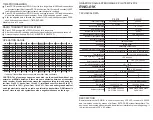
• Block valves isolate the regulator
• Vent valves are closed
• A bypass, if any, is in operation
In all cases, check the control spring setting to make
sure it is correct for the application.
CAUTION
Be sure to slowly introduce pressure
into the system to prevent downstream
overpressure due to potential rapid
pressure increase. Pressure gauges
should always be used to monitor
downstream pressure during startup.
Procedures used in putting this
regulator into operation must be planned
accordingly if the downstream system is
pressurized by another regulator or by a
manual bypass.
Startup
1. Make sure all block valves, vent valves and control
line valve(s) are closed.
2. Back out the pilot adjusting screw(s).
3.
Slowly open
the valves in the following order:
a. Pilot supply and control line valve(s), if used.
b. Inlet block valves.
4. Crack open the outlet block valve or bypass valve
to allow minimum flow.
5.
For a single regulator
, set the pilot to the
desired outlet (control) pressure according to the
Pilot Adjustment procedure.
For a wide-open downstream monitor
installation
, adjust the upstream working pilot until
intermediate pressure is higher than the desired
setpoint of the monitor pilot. Adjust the downstream
monitoring pilot to the desired monitoring takeover
pressure. Reduce the upstream pilot to the normal
outlet pressure setting.
For a wide-open upstream monitor installation
,
adjust the downstream working pilot to a setpoint
higher than the setpoint of the monitor pilot. Adjust the
upstream monitoring pilot to the desired monitoring
takeover pressure. Reduce the downstream pilot to
the normal outlet pressure setting.
For a working monitor installation
, back out the
adjusting screw of the downstream pilot. Adjust the
upstream working pilot to the desired intermediate
pressure setting. Back out the adjusting screw of
the upstream monitor pilot (Type PRX/125). Drive in
the adjusting screw of the downstream pilot. Adjust
the upstream monitor pilot to the desired setpoint.
Establish final desired downstream pressure by
adjusting the downstream pilot.
6. After adjusting the pilot(s) to the desired pressure
setting(s), slowly open the downstream block
valve wide-open.
7. Close the bypass valve, if used.
Pilot Adjustment
The adjustment of the regulators is performed by
means of the pilot adjustment screw, which varies
the compression of the control spring. Adjustment is
performed while the regulator is in in operation with
the aid of a pressure gauge to monitor downstream
pressure. The shutoff valve downstream of the
regulator must not be completely closed, as it
is necessary that a small quantity of gas flows
downstream to allow the outlet side to vent, when it is
necessary to lower the pressure.
Remove closing cap, if necessary. Loosen the
locknut. Turn the adjusting screw into the spring case
(clockwise) to increase the downstream pressure.
Turn the adjusting screw out of the spring case
(counterclockwise) to decrease the downstream
pressure. When the desired setpoint adjustment is
completed and verified, tighten the locknut to lock the
adjusting screw in position. Replace the pilot closing
cap, if necessary.
Adjusting the monitor regulator (Figure 4) is the same
as adjusting the main regulator. Monitor setpoints
are set slightly higher than the main regulator. The
monitor pressure setting should be adjusted so it is at
minimum two times the pilot accuracy band pressure
above the working regulator pressure setting.
Shutdown
CAUTION
If the pilot bleed control line pressure is
shutdown first, the downstream system
may be subjected to full inlet pressure.
1. If the pilot setting must be disturbed, be sure to
keep some tension on the spring. This will prevent
trapping inlet pressure during blow down.
2. Slowly close the valves in the following order:
a. Inlet block valve
b. Outlet block valve
c. Control line valve(s), if used.
3. Open the vent valves to depressurize the system.
8
Type EZL









































